|
Duke Stanislas redeveloped the area linking the old and new towns of Nancy, building his three famous squares (places in French) on the esplanade that had replaced part of the city’s ramparts. From north to south they are the Place de la Carrière, Place Royale (today’s Place Stanislas) and Place d'Alliance, the last two being raised in honour of King Louis XV, the son-in-law of Duke Stanislas, former King of Poland.
UNESCO drew up its first World Heritage List thirty years ago. It now includes 370 sites and monuments all over the world. More than 20 sites in France have been awarded this honour. The magnificent 18th Century group of buildings in Nancy has been on the list since December 1983 when it was chosen as being of “truly outstanding interest and representing universal values".
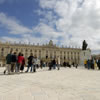
Place Stanislas. Considered the most beautiful royal square in Europe and high point of Nancy’s outstanding collection of 18th Century monuments, on UNESCO’s World Heritage List, the city of Nancy is known all over the world thanks to Place Stanislas. A magnificent example of Classical French architecture built by Emmanuel Héré, it is surrounded by the wrought-iron worker Jean Lamour’s finely worked railings with gold highlights. The Square’s majestic fountains are by Barthélemy Guibal. Famous buildings surrounding the square include the City Hall, the Theatre-Opera House, the Fine Arts Museum... Learn more…

Place d'Alliance. This tiny square, smaller and more intimate, is part of Nancy’s UNESCO-listed, 18th C architectural ensemble. It was named in honour of the alliance between the Hapsburg House of Lorraine and the Royal House of France. A magnificent fountain occupies the middle of the square, Cyfflé’s copy of Bernini’s famous fountain in Piazza Navona in Rome.
This square originally called Saint Stanislas Square is part of the architectural unity commissioned by Stanislas from Emmanuel Héré, to be built on the site of the Duke's kitchen garden. A baroque fountain by the sculptor Cyfflé, which to begin with, was originally stand in the centre of the semicircle on Carrière Square was finally installed here.
It is a symbol of the alliance in 1756 between the Austro-Hungarian Empire and France and is the origin of the name of the square.
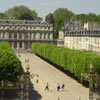
Place de la Carriere. The third square forming part of the UNESCO-listed 18th Century ensemble of buildings and monuments in Nancy, this square was originally laid out in the 16th Century when it was used for jousting and tournaments, hence its name Carrière. It was redeveloped in the 18th Century to create a more symmetrical perspective. Two mansions face each other at the entry to the square: Hôtel de Craon (today’s Court of Appeal) and the Bourse de Commerce (today’s Administrative Tribunal). The Palais du Gouvernement lies across the other end, framed by two semicircular colonnades decorated with antique gods.
Learn more…
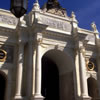
Triumphal Arch. A copy of Septimus Severus’ Arch in Rome, it glorifies King Louis XV through its ornamentation: bas-reliefs, inscriptions …. It is topped by an acroterium celebrating Louis XV as Victor and Peacemaker and decorated with a medallion of the King. The triumphal arch was built to honour Louis XV at the same time as Stanislas Square. This impressive gate was built in the middle of the ramparts separating the Old Town from the New Town. It is a reminder of the Triumphal Arches set up by the Roman emperors to glorify themselves and in particular the one for Septimius Severus in Rome. Elegant columns on plinths frame the three arches on both sides while an attic storey with reliefs crowns the whole edifice, itself topped with statues situated vertically above the columns. The decorations are centred on the theme of war and peace (referring to the victory of Fontenoy and the treaty of Aix-la-Chapelle). A gilded medallion of Louis XV in profile dominates the entire structure.
This refers to the town which expanded rapidly in the Middle Ages around the Duke’s castle. In the 16th Century the most modern defensive walls and bastions of the period were built to protect it. Nothing remains of them today except for a small part of the walls discovered during the renovation of the Fine Arts Museum. The extensive restoration work carried out over the last 15 years makes it one of the high points of Nancy’s heritage.
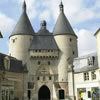
The Craffe Gate. The oldest part of Nancy’s fortifications, it was built in the 14th Century and was subsequently used as a prison for many years. In the 17th Century, another gate, called the Notre-Dame Gate, was built to further protect this entrance to the city. The two gates were separated by moats at the time.
This impressive gateway into Nancy was built at the end of the 14th century as part of the walls encircling the town. The large twin towers flanking the gate were added on at the end of the 15th century and were used as prisons. The small lantern above the main gate dates back to the 17th century and contained a bell which rang out the hours of the day, the beginning of the curfew and informed the population of public executions. The Lorraine Cross on the facade is a reminder that the emblem was adopted after the victory of the Battle of Nancy.
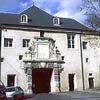
The Citadelle Gate. Duke Charles III had this gate built in the 17th Century to double up and further reinforce the city’s defenses. At the time it was surrounded by four bastions and separated from the Craffe Gate by moats that were gradually filled in over the centuries. The bridges linking the gates were removed in the 19th C when the buildings around the gates were demolished.
The Citadelle Gate was commissioned by Duke Charles III from the Italian architect Orfeo Gallieni to duplicate the Craffe Gate. It was originally called the Notre Dame Gate because of a statue of the Virgin and Child on the pediment above the gateway. The statue was unfortunately taken down during the French Revolution but replaced in 1863 by a statue of Charles III holding the charter of the University of Pont-à-Mousson of which he was the founder.
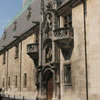
The Duke's Palace. The Duke’s Palace, built in the 15th Century, was originally the residence of the Dukes of Lorraine. Abandoned by Duke Leopold, who moved to Lunéville in the 18th Century, it had a somewhat checkered history before becoming the Lorraine Museum in 1848. It has a remarkable gatehouse, inspired by that in Blois, combining elegant Gothic art with that of the Italian Renaissance.
The building of the Dukes' Palace began in 1502. All that remains nowadays of the residence of the Dukes of Lorraine is the wing on Grande-Rue (high street) and the Porterie (the gateway) the latter, modelled on the one in Blois, combines flamboyant Gothic and Renaissance styles. It includes a niche with an equestrian statue of Duke Antoine -the restauration of the original group destroyed during the French Revolution.
The palace was destroyed in part and redesigned by Boffrand during the reign of Leopold and then turned into stables by Stanislas. Part of it was occupied by the gendarmerie in the 19TH century before being converted into a museum by the "Société d'Archéologie de Lorraine" at the end of the century.
After a fire in 18TH century, it was restored once again, but although its appearance was slightly modified it regained its original mullioned windows, high sloping roofs, and gargoyles. It became the Lorraine Museum in 1937.

The Church of the Cordeliers. The Church of the Cordeliers is called after the Franciscan Order whose members wore a cord around their waist. It was built in the 15th Century by order of Duke René II, following the Battle of Nancy. Lorraine’s Saint-Denis (burial place of some of France’s famous kings), in spite of many depredations through the ages, it still has some remarkable tombs. The chapel, inspired by that of the Medici’s in Florence, is outstanding.
The Cordeliers’ Monastery, adjoining the Church, now holds the Museum of Popular Art and Tradition that presents works illustrating rural life in Lorraine and reconstitutions of Lorraine interiors.
Learn more…
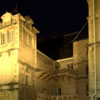
Haussonville Mansion. Named after the priest who built Saint-Epvre's Basilica, Rue Monseigneur Trouillet has a number of beautiful mansions, in particular the Haussonville Mansion. Admire the facade giving onto the courtyard; its beautiful balustrades were carved in two different periods, Flamboyant Gothic and Renaissance. The mansion also has a beautiful trompe l’œil doorway. The Haussonville Mansion dates back to the 16TH century and is one of the most beautiful houses in the Old Town. It is built of two main parts set at an angle. One can admire two particularly gracious galleries, one of open-stonework in the gothic style running along the first floor, and the other in the renaissance style along the second. A classical statue of Neptune decorates the fountain in the courtyard and the wooden door to the stairway is a remarkable example of trompe-l'oeil. It now houses a luxury four star Hotel.
The Ferraris Mansion. A magnificent private mansion dating from the 18th Century, its classic facade hides a sumptuous staircase whose wrought-iron handrail is by Jean Lamour and the painted sky above by Barilli, the great Bibiena’s pupil. The courtyard, typical of the period, has a Neptune fountain.
This 18TH century mansion, by Boffrand, is the finest of the stately homes in Nancy.
The grand staircase with its hand rail by Jean Lamour is surmounted by a loggia painted in "trompe-l'œil" by an Italian artist. A fountain takes up one wall of the courtyard with the sea god Neptune in the place of Honour leaning on one of his sea-horses. The two attractive groups of chubby children playing with dolphins which flanked the statue of Neptune were removed after World War I.
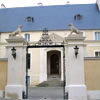
The Mansion des loups. In Rue des Loups (of the wolves), to which it owes its name, this mansion was built in the 18th Century by Germain Boffrand. Its monumental gate is topped by two stone wolves reminding us that its owner was the Duke of Lorraine’s Master of the Wolf Hunt.
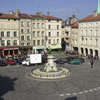
Saint-Epvre basilica and Square. The market square and general trading centre in the Middle Ages, the fountain in the middle has a statue of Duke René II of Lorraine, who defeated Charles the bold, Duke of Burgundy, at the Battle of Nancy in 1477.
Built in the 19th Century by Prosper Morey, Saint-Epvre’s Basilica is decorated with stained glass and wood panelling in part made in Bavaria. It was richly endowed by Napoleon III, Emperor Franz-Joseph, Ludwig II of Bavaria and Pope Pius... who donated the beautiful stone paving in the choir that came from the Appian Way.
The Saint Epvre Church towers above one of the largest and busiest squares in the old town. Up till the end of the 19th century the square with its fountain topped by a statue of Duke Rene II was the site of the town's market. The present-day Basilica (it is not the cathedral) was built in the second half of the 19th century in the current gothic revival style. Among its generous donors were Napoleon III of France and the Emperor Francis Joseph I of Austria. Much of the interior decoration was due to artists from numerous European countries.
The New Town
Founded by Duke Charles III in 1588, with its streets all at right angles the New Town has a totally different layout from the Old. It has its own market square and a famous parish church: the Primatial (today’s Cathedral). It was in a position to rival the Old Town as it even had its own independent fortifications. The New Town is in the process of being restored today.

The Cathedrale. Designed by the architects Jules Hardouin-Mansart and Germain Boffrand, it was built at the start of the 18th Century. The railings are by Jean Lamour; the cupola was painted by Jacquard and the organ is a scheduled monument. It has several interesting 17th and 18th Century paintings of the Lorraine School.
The church was built at the beginning of the 18th century according to plans by three successive architects, Giovanni Betto, Jules-Hardoin Mansart and Germain Boffrand. It was originally the see of the Primate of Lorraine and only became the cathedral in 1777 after the death of Stanislas. Of interest are the chapel screens by Jean Lamour, statues of the Virgin Mary from the 15th and 17th centuries, and the painted cupola above the crossing which features one hundred and fifty biblical figures, the Doctors of the Church and the Holy Trinity.
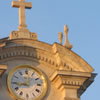
Saint-Sebastian's Church. Overlooking a very lively open-air market, Saint Sebastian’s Church was built in the 18th Century to plans for a hall-church with an incurved facade inspired by that of Saint Agnes in Rome.
This 18th century baroque church with its curved facade was influenced by the Saint Agnesa Church in Rome. Imposing statues of two dukes of Lorraine, Leopold and Stanislas keep watch over the Church and the neighboring Market place. In the interior the life of Saint Sebastian is depicted on the cupola over the crossing.
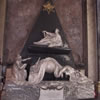
Notre-Dame de Bonsecours Church. When the Battle of Nancy came to an end, thousands of corpses were buried in a vast ditch near the Jarville stream. In 1484, a priest obtained Duke René II’s permission to build a chapel and a hermitage there. The sanctuary, named Notre-Dame-de-Bonsecours by the Duke, was sometimes called the Church of Our Lady of Victory and the Kings.
On the site of the graves of the Burgundians who died at the Battle of Nancy and that of a modest sanctuary remodeled in the 17TH century, Emmanuel Héré was commissioned by Stanislas to build a baroque church in which he lies at rest along with his wife and close to the heart of his daughter Maria Leszczynska, wife of king Louis XV.
|
